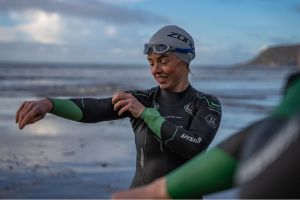I get a lot of people saying that their pace in the pool does not translate over to the open water and they want to know how to improve on that? I think there are a lot of factors that go into this such as: proper wetsuit fit, comfort in the open water, and race strategy & pacing. Let's dive into more detail on each topic…
Proper Wetsuit Fit:
I remember my first couple of years in the sport of triathlon where I wore my husband’s old wetsuit at races. While we aren’t too different in size, the wetsuits never fit me right, and I always struggled with finishing the swim portion. I was a strong swimmer, but I could barely get my arms out of the water by the end of the swim. Water would creep into the wetsuit and I felt like I was carrying around 10 extra pounds every time I raised my arm out of the water. I realized that I needed to find a better wetsuit that fit correctly and that would help me swim faster.
Many wetsuit companies are at race expos so that you can try out their wetsuit. Some companies also allow you to have a free trial at home to see if you like the fit or not. It is imperative to find a wetsuit that suits your buoyancy needs, fits your neck correctly and doesn’t rub, and that doesn’t put a lot of pressure on your shoulders. Wetsuits should be tight, but not cut off your circulation, and should give you enough flexibility to move your arms comfortably. A wetsuit that is too big will carry extra water and weight so you need one that is right for you. Take advantage by reaching out to companies or friends to try out different wetsuits so that you find one that works best for you! The properly fitted wetsuit will definitely help you to swim faster.
Comfort in the Open Water:
Another thing that will help you swim faster is being comfortable in the open water. If you aren’t used to open water swimming, you may be timid come race day and not perform to your potential. It’s important to make sure you practice open water swimming before you attempt a race, so that you can get used to different water conditions, swimming with other people, and sighting.
There are drills that you can do in the pool to help you get more comfortable with open water swim conditions. Do some 25s in the pool with multiple people in your lane swimming next to one another so you can feel what this is like. Also, put a cone at the end of the lane and practice your sighting. Being able to sight and breathe efficiently in the open water will definitely help you swim faster too. Work on these changes from the pool to open water swimming because being more comfortable will help you be able to swim at your normal speed and not slow down due to concerns of being surrounded by others or unable to sight. Better sighting will also help you to swim in a straight line and therefore, swim faster.
It is important to try and get in different open water conditions so that you are prepared for what might come on race day. If you will be swimming in a lake with zero waves, then practicing your open water techniques in the pool may be sufficient enough. If you will be swimming in the ocean, with constantly changing conditions, try and get in these water conditions beforehand with some friends. You will want to learn how to increase your tempo if you’re in very wavy conditions and also use different breathing techniques. When waves are large, you will need to lift your head up more to see the buoys, and you might need to breathe to either side depending on which way waves are coming from. Search previous history of race conditions so that you can be prepared, more comfortable with the water conditions, and then ultimately you will swim faster.
Race Strategy and Pacing:
There are multiple factors that go into race strategy and pacing, all of which will help you perform to the best of your ability when it comes to open water swimming. Before your race, it is important to warm up and this can either be done in the water or by stretching and jumping around on land. If you start your race without warming up, then you will not be able to swim your race pace for the entire swim because it’s probably taking too long to get into that pace. If you want to be ready to go, then spend 10 minutes priming your body to swim fast.
During your race, make sure you are either setting your own pace or swimming on someone’s feet that is setting a good pace for you. If you want to have clear water and be able to set your own pace, then try to start in the front or on the side of the start line so that you have the opportunity to do this. If you are swimming behind someone, continue to monitor the pace, and if it’s too easy, then go around them. If you have a specific swim goal, then keep on the pace throughout the entire swim by not taking it out too fast and monitoring your effort often.
There are a lot of strategies that go into swimming fast in the open water. Make sure to get a properly fitted wetsuit, practice your open water technique including swimming with people and sighting, and finally make sure you are prepared to set a good pace come race day and be prepared for the different water conditions.






















